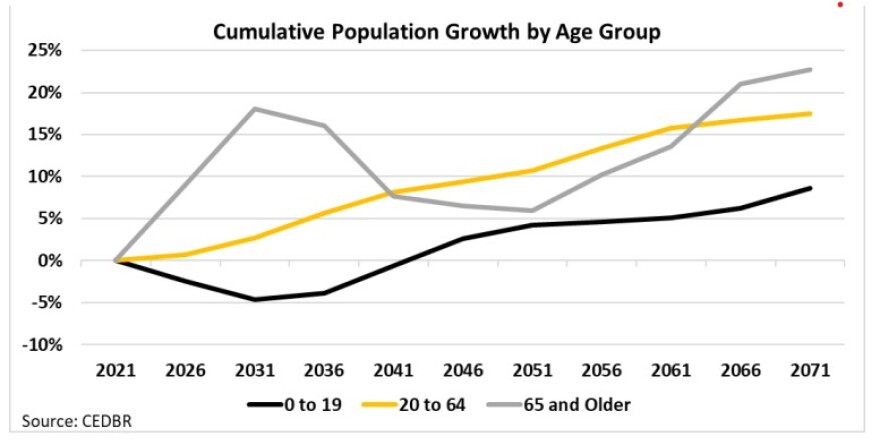The population of Kansas is forecast to grow more slowly in the next 50 years than previously predicted, according to new projections by Wichita State University’s Center for Economic Development and Business Research.
It’s also growing more slowly than the U.S. population as a whole.
The state’s total population is predicted to grow about 16% in the next fifty years, adding 468,000 residents by 2071.
Annual growth in Kansas is expected to average 0.32% through 2071. Predictions from about five years ago estimated 0.4%, according to Jeremy Hill, the center’s director.
From 1960 to 2010, Kansas saw more vigorous population growth than both of the estimates at around 0.54%.

That robust growth changed in 2010 in the aftermath of the Great Recession. In some cities, like Wichita, the shrinking economy meant working families moved out of state, Hill said.
“We have had an outmigration of a lot of that working-age female populations over this last several years,” Hill said, “which is going to take a big anchor to the potential growth of the state economy.”
The growth rate Hill is predicting over the next 50 years is an acceleration compared to the last decade. But the state is still feeling the aftereffects of what it means that working age families moved out of state.
“That kind of drained that population base. So they’re not physically here to have babies,” Hill said.
Youth, aged 0 to 19, are predicted to be the slowest-growing age group in the next 50 years, compared to 20-64 year olds and 65-plus-year-olds.

Hill also said Kansans are delaying having children or having less for a number of reasons, including high housing and childcare costs that make it difficult to afford to start a family.
Meanwhile, the 65-plus population is growing the fastest – at more than twice the annual rate youth is growing. Hill said that will mean a shift in the services government agencies and nonprofits might need to provide. It also means an aging and shrinking workforce.
Minority groups are also buoying Kansas’ population with rapid growth. The number of Black and Hispanic residents in the state is predicted to grow about five and 10 times faster, respectively, than white residents in the next 50 years. The population that identifies as another minority race is growing even faster.
“We already knew we were growing in minorities,” Hill said. “But it’s really the white population going to almost no growth at all … that was probably the biggest surprising overall factor. I knew it was slowing, but I didn’t know it was slowing that much.”

Wichita growing, but not as fast as other major metros
Most metropolitan areas in the state, including Wichita, will likely see their population surge faster than rural areas, which are expected to see population declines.
Wichita and surrounding counties are predicted to grow about 23 percent between 2021 and 2071.
That’s less than the metro areas of Kansas City, Lawrence and Manhattan.
One reason for this is because Wichita is still recovering from the Great Recession and the exodus of working families that came with it, Hill said. He added that Wichita is also just small enough to miss out on national investment that goes to more major cities like Kansas City.
“The largest of metro areas across the U.S. continue to have what’s called a growth magnet,” Hill said. “It’s already large, already been growing and people continue to invest in these big, big larger cities. And Wichita’s kind of this larger tier which doesn’t quite get that.”
But Wichita is growing faster than some other metropolitan areas like Emporia, Hays and Topeka, which is forecast to decline by 3.2% by 2071.



